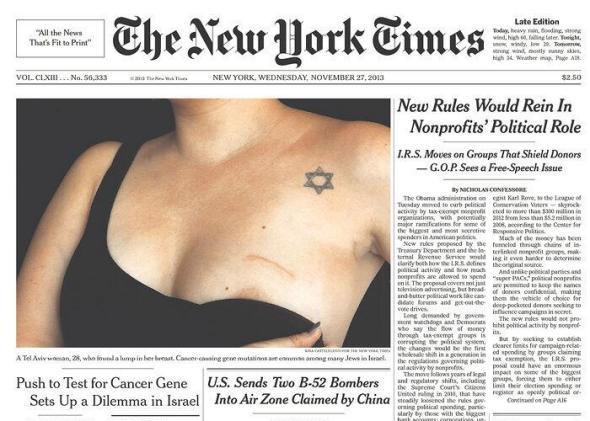Earlier today, my colleague Amanda Marcotte wrote about the New York Times’ decision to run an A1 above-the-fold photograph of an Israeli breast cancer survivor, her tank top lowered to expose a lumpectomy scar and part of her areola, to illustrate a story about breast cancer screening. Marcotte laid out three ways of looking at the image, but came down hard on the side of a single interpretation: “It’s grossly inappropriate to sexualize breast cancer, which is a serious and deadly disease.”
How did the Times objectify this woman, according to Marcotte? Because she’s wearing a tank top. Because lowering her tank top to show part of her breast “is reminiscent of a strip tease shot.” Because a strip tease shot to illustrate a story on breast cancer is part of “the sexualization of discourse around breast cancer,” which “strongly implies that the main reason to keep women alive is as life support for their delicious breasts.” With this shot, Marcotte says, the Times “proved that they’re as dependent on WTF traffic as everyone else.”
Ways of seeing are subjective, but to my eye, the Times picture—un-airbrushed, matter-of-fact—does not sexualize cancer. Or rather, it doesn’t sexualize cancer any more or less than breast cancer sexualizes cancer, because breasts are secondary sex characteristics and often play a significant role in a woman’s sexual health and fulfillment. If a woman sees her breasts as part of her personal and sexual identity, that doesn’t mean she’s somehow the self-objectifying victim of patriarchal social conditioning. To think otherwise is to suggest that a woman with breast cancer can’t be sexual, and by extension, that she shouldn’t allow a camera to capture her allegedly controversial sexuality. (To me, the only aspect of the picture that suggests objectification is the fact that the woman’s head is cropped out, but that was likely due to privacy concerns.)
The understandable agony of deciding whether or not to remove a part of one’s body, the extremely difficult calculus involved in weighing one’s health options, others’ empathy for that agony—none of these are remotely equivalent to perceiving women as “life support for delicious breasts.” Lots of misogynist trolls think that way, sure. And some of the Israeli doctors referred to in the piece seem to as well. But an areola on the cover of the Times does nothing to validate the views of misogynist trolls or moronic physicians. If anything, it’s a welcome step forward in dissipating the misogyny-driven occult power around the terrifying and mysterious breast, whether the issue is the BRCA1 genetic mutation or feeding one’s baby in public.
Marcotte writes that her heart is with those of us who despise Puritan prudery, but a puritanical society is exactly what equates “breast” with “WTF traffic.” The Times picture doesn’t strengthen the taboo—it dismantles it. Demystifying the breast is good for women. The Times got this one right.
